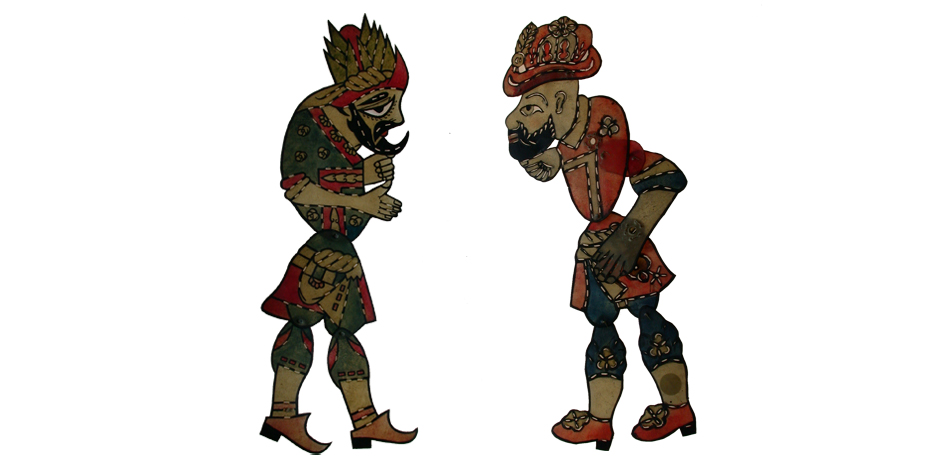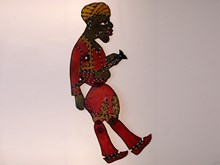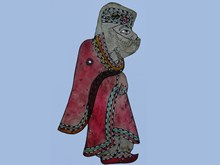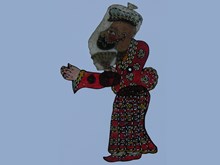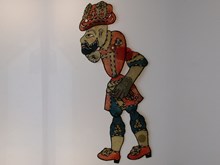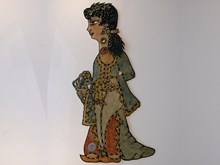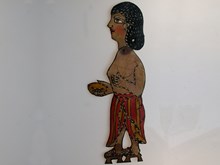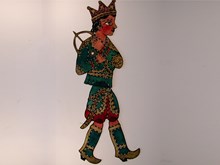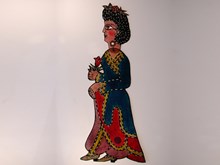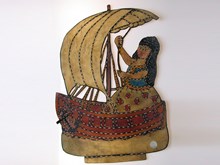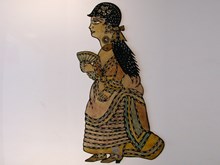Shadow Puppets Karagöz-Hacivat Collection
Yapı Kredi Vedat Nedim Tör Museum
Karagöz-Hacivat and Ragıp Tuğtekin
The shadow puppets collection owes its existence to grand master of Karagöz plays Ragıp Tuğtekin, who personally made every single figure out of camel skin in the 1930s. Grouped according to plays and scenes, this substantial collection includes not only the two main protagonists Karagöz and Hacivat, but also other characters as well as creatures, trees, plants and animals that complete the scenery.
The main plays and figures in the collection are
Tahir and Zühre: 8 figures
Ferhat and Şirin: 7 figures
Characters: Karagöz, Hacivat, Stutterer, Black Slave and Jew, Circassian, Woman, Emigrant, Zeybek (Turk from south-western Anatolia), Matiz (Deli Bekir), Addict, man from Kayseri Kurd, Himmet Dayı, Persian and Dwarf.
Other characters are Crazy Doctor, Kopuk, Footman, Albanian, Deli Bekir, Karagöz’s son, Hacivat’s son, Karagöz’s wife, Hımhım (Person speaking through his nose), Laz (Inhabitant of the shores of the Black Sea), Eunuch, Rabbi, Mehmed the Hunchback, Islander, and Mother with Child.
A total of 187 figures comprise the play repertoire: “Bloody Nigâr, Kağıthane Excursion , Mismarriage Bath House Game, Stupid Watchman, Circumcision Party, Bloody Poplar, Garden, Women, Songs and Boy Dancers, Ballet Dancers, Bards, Scribes, Yalova Excursion and Witches.”
This collection was purchased from the master himself in the 1950s.
Tuğtekin’s handwritten descriptions in Ottoman and bound caskets for the figures accompany the puppets; the descriptions include the play, scene and figure names. An integral part of the collection, these caskets are also carefully preserved.
An interview with the Karagöz master Ragıp Tuğtekin
-Your name and surname?
-Ragıp Tuğtekin
-Your place and date of birth?
-İstanbul 1891
-And your education?
-Mercan Lycée
-Your real profession?
-I’m a retired civil servant; I used to work at the District Hall. I have also taught Art and Physical Education at the Afyon Teachers’ College and took music lessons from the Çankırı Mevlevi Sheikh Hüsamettin Hasip Dede, who also taught me to play the tambour.
-How did you get into Karagöz shadow play? Who were your instructors?
-Let me explain how I got into Karagöz shadow play: it was through the offices of Nazif Efendi and Tecelli Bey, both now sadly deceased. I met these two gentlemen whilst still at junior school. They cut out and made their own figures and staged plays at private events such as enthronement and birth celebrations, at the drawing room of a small palace. The audience would include Ahmet Rasim, Mahmut Sadık, Hasan Bedrettin, Nazif Efendi and family and others whose names I cannot remember. I was intrigued enough to watch the screen permanently set up in the drawing room, moving around to see the action behind the screen from time to time. I had the late Nazif Efendi’s and the late Tecelli Bey’s figures to hand. I would trace them in card, study the Karagöz scripts then available and put on a show for my neighbours. The greatest artists of the time were Kâtip Salih, Soğukçeşme Rufai Lodge Sheikh Fehmi Efendi, Sefer Mehmet (Camcı İrfan’s instructor), and Kantarcı Hakkı, who would perform at Ramadan nights in particular, that being the time of year for Karagöz plays. Their techniques (whether personally used or not) still survive to our time: clipping the figures to the rods on- or off-stage, sliding them onto the screen, i.e. the entrances of the figures as required by the script, holding the figures either by ties or in the hand, a maximum of four at a time (only used by the late Tecelli Bey) and the use of the ‘puppet tree’, a catapult shape with holes for the puppeteer to temporarily place the figures by the rods; the puppeteer also might rest the rods on his chest to give both hands the liberty to manipulate the figures behind the screen. As for me putting a Karagöz show on: I only perform once or twice a year amongst friends or to liven up the occasional party, all strictly on an amateur basis. I’ve never performed in public venues or official sites such as Community Centres.
-What are the plays in your repertoire?
-There’s not much more than a dozen Karagöz plays. Some of the best known are “Tahir and Zühre, Ferhat and Şirin, Bloody Poplar, Poets, Asylum, Bloody Nigâr, Yalova Excursion , Kağıthane “Excursion”, Mismarriage, “Witches or Testing the Wizards, Swings, Stupid Watchman, Dairy Farm”, and” Landed Gentry”. I’ve never been involved with newer scripts that aren’t necessarily authentic. Karagöz’s circumcision in “Dreams within Dreams”, for instance, was a very old play only performed by Hayâl master Emin Agha. I’ve not come across anyone else performing it. The scenes with the Black Slave, LiarLiar, Masana and Ham Hum, for instance, are not plays in their own right; instead, they are sub-plots added to stretch the main play. I have witnessed that the masters referred to earlier always paid a great deal of attention to their favourite plays. Katip Salih Bey, incidentally, has invented the addition of songs as well as sub-plots into the plays to extend the running time even further. Tecelli Bey usually performed “Improper Wedding”, Sheikh Fehmi Efendi “Witches”, Katip Salih Efendi “Poets”, and Sefer Mehmet Efendi performed “Tahir and Zühre”. The plays I have the honour to occasionally perform when asked are “Improper Wedding, Kağıthane Excursion, Yalova Excursion and Bloody Nigâr”.
-Do you make your own Karagöz figures? Who taught you this art?
-Allow me to explain how I progressed from cardboard figures to leather. I gathered up the courage one day to mention this wish whilst I was in the presence of Tecelli Bey and Nazif Efendi. The late Nazif Efendi told me about imported slipper leather available in some shops in the vicinity of Tahtakale; properly cleaned, these pieces of leather would be suitable for figure making. I obtained some, cut them to shape with a penknife and a nail and painted them with red and blue dyes then sold in bottles. That’s how I began making my own figures and continued on and off. After my appointment to Istanbul in 1940, I made figures almost continually, out of whatever I could lay my hands on: camel-, goat- and calf skins and knives of all types. I must have cut between ten and twelve thousand. When camel skins of the required quality were no longer so readily available, a Balıkesir saddler called Kâzım Usta offered calf skins instead. He’s now quite elderly; how much longer this artist can keep assisting me, I have no idea. I have created three substantial collections over the course of these thirty-five years; sufficient to stage all Karagöz plays, each comprises between 150 and 180 figures. I have also made figures for connoisseurs in England, Germany, Italy and America on a retail basis; I despatch between twenty and forty pieces and also supply bespoke orders for Karagöz puppeteers.
-Have you got any more collections?
-As I have noted earlier, Metin And has one of my collections, Yapı Kredi another and the third is with a German businessman, owner of a chemical works in Berlin. I personally have a 130-piece collection that enables me to perform Karagöz plays.
-Have you trained any apprentices?
-I trained engineer Orhan Kurt in cutting figures upon his request. The Culture Directorate held a course last year for people wishing to learn how to make figures in the first stage. We will add performing to the syllabus should the course continue. This will hopefully enable the preservation of Turkish performing arts -widely accepted as authentic throughout the world: Karagöz, certainly, but also its inseparable partners the Orta Oyunu -theatre-in-the-round- and even string puppets.
-What are your thoughts on preserving Karagöz?
-I am absolutely against the alteration of figure-making or the play scripts. Given how remote today’s generations are from Ottoman Turkish and Ottoman literature, the scripts might be modernised by able hands in authority. So long as Karagöz and Hacivat characters remain unaltered, the male and female figures might be brought up to date.
Interviewed by Nail Tan T.F.A No: 303 - October 1974
